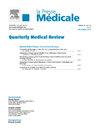From stem cells to organoids in thyroid: Useful tools or a step for cell therapy?
IF 3.4
3区 医学
Q1 MEDICINE, GENERAL & INTERNAL
引用次数: 0
Abstract
Organoids are three-dimensional tissue cultures derived from stem cells. They replicate the complexity of different cell types in an organ and can survive in specific media. They also have the capacity to proliferate and self-renew. Thyroid organoids have now been established using a variety of cell sources, including murine or human embryonic stem cells, pluripotent stem cells, adult thyroid-derived stem cells, and even fetal thyroids. Experimental designs to obtain thyroid organoids depend on the originating cell types and whether a forced (transient or permanent) overexpression of two important transcription factors in thyroid development, Nkx2–1 and Pax8, has been used by lentiviral transduction. All cells are harvested in an extracellular membrane to achieve a three-dimensional cell culture. The development of strategies to obtain organoids has revealed the signaling pathways and growth factors that are essential for this type of culture, and which are also essential for thyroid development. The development of thyroid organoids has facilitated a deeper understanding of the key factors and stages involved in the differentiation of stem cells into thyroid follicular cells. Furthermore, they have demonstrated utility as a model for pathology, such as Graves' disease. Insights regarding other thyroidal pathologies will likely emerge in the future. Furthermore, thyroid organoids have demonstrated their potential for regenerative medicine, a promising but not yet fully efficient technology for treating definitive hypothyroidism.
从干细胞到甲状腺类器官:有用的工具还是细胞治疗的一步?
类器官是来源于干细胞的三维组织培养物。它们在一个器官中复制不同细胞类型的复杂性,并能在特定的培养基中存活。它们也有增殖和自我更新的能力。甲状腺类器官目前已建立使用多种细胞来源,包括小鼠或人胚胎干细胞,多能干细胞,成人甲状腺来源的干细胞,甚至胎儿甲状腺。获得甲状腺类器官的实验设计取决于原始细胞类型,以及慢病毒转导是否强制(短暂或永久)过表达甲状腺发育中的两个重要转录因子Nkx2-1和Pax8。所有的细胞都在胞外膜中收获,以实现三维细胞培养。获得类器官的策略的发展揭示了这种类型的培养所必需的信号通路和生长因子,这也是甲状腺发育所必需的。甲状腺类器官的发展促进了对干细胞分化为甲状腺滤泡细胞的关键因素和阶段的深入了解。此外,它们已经证明了作为病理学模型的效用,例如格雷夫斯病。关于其他甲状腺疾病的见解可能会在未来出现。此外,甲状腺类器官已经证明了它们在再生医学方面的潜力,这是一种有希望但尚未完全有效的治疗甲状腺功能减退症的技术。
本文章由计算机程序翻译,如有差异,请以英文原文为准。
求助全文
约1分钟内获得全文
求助全文
来源期刊

Presse Medicale
医学-医学:内科
自引率
3.70%
发文量
40
审稿时长
43 days
期刊介绍:
Seule revue médicale "généraliste" de haut niveau, La Presse Médicale est l''équivalent francophone des grandes revues anglosaxonnes de publication et de formation continue.
A raison d''un numéro par mois, La Presse Médicale vous offre une double approche éditoriale :
- des publications originales (articles originaux, revues systématiques, cas cliniques) soumises à double expertise, portant sur les avancées médicales les plus récentes ;
- une partie orientée vers la FMC, vous propose une mise à jour permanente et de haut niveau de vos connaissances, sous forme de dossiers thématiques et de mises au point dans les principales spécialités médicales, pour vous aider à optimiser votre formation.
 求助内容:
求助内容: 应助结果提醒方式:
应助结果提醒方式:


